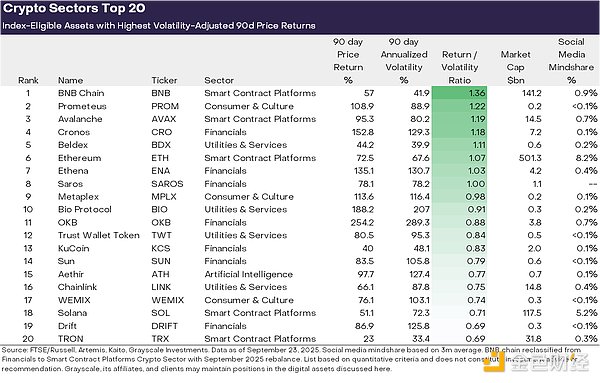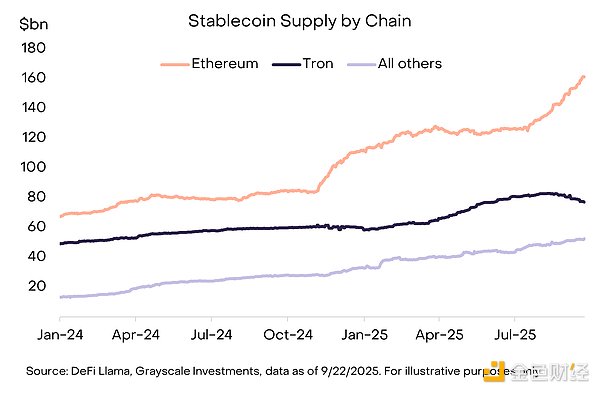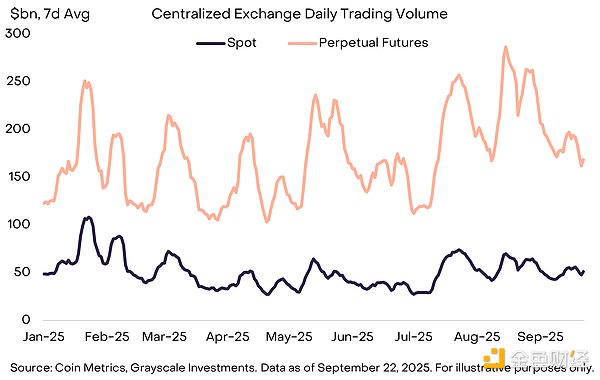Bitcoin underperformed other cryptocurrencies, and the return pattern for other cryptocurrencies can be considered an "alt season"—albeit a different pattern from past ones. A ranking of the top 20 tokens in Q3 (based on volatility-adjusted price returns) highlights the importance of stablecoin legislation and adoption, rising trading volumes on centralized exchanges, and digital asset treasuries (DATs). Every asset in the cryptocurrency sector has some connection to blockchain technology and shares the same fundamental market structure—but that's where the similarities end. The asset class encompasses a wide range of software technologies, with applications in consumer finance, artificial intelligence (AI), media, and entertainment. To organize the data, Grayscale Research uses a proprietary taxonomy and index series, known as "Crypto Sectors," developed in partnership with FTSE/Russell. The "Crypto Sectors" framework covers six distinct market segments (Exhibit 1). Together, they encompass 261 tokens with a combined market capitalization of $3.5 trillion. Figure 1: The "Crypto Sector" Framework Helps Organize the Digital Asset Market. Measuring Blockchain Fundamentals: Blockchains are not businesses, but their economic activity and financial health can be measured in a similar way. The three most important indicators of on-chain activity are users, transactions, and transaction fees. Because blockchains are anonymous, analysts often use "active addresses" (blockchain addresses with at least one transaction) as an imperfect proxy for user numbers. Fundamental indicators of blockchain health were mixed in Q3 (Figure 2). On the negative side, the number of users, transaction volume, and fees in the cryptocurrency sector, both for currencies and smart contract platforms, all declined quarter-over-quarter. Overall, meme-coin-related speculation has declined since Q1 2025, contributing to a decline in trading volume and transaction activity. More encouragingly, blockchain-based application fees increased by 28% quarter-over-quarter. This growth was driven by activity from a handful of leading applications by fee revenue: (i) Jupiter, a Solana-based decentralized exchange; (ii) Aave, a leading lending protocol in the cryptocurrency space; and (iii) Hyperliquid, a leading perpetual futures contract exchange. On an annualized basis, application-layer fee revenue has now exceeded $10 billion. Blockchains are both networks for digital transactions and platforms for applications. Therefore, higher application fees can be seen as a sign of the growing adoption of blockchain technology. Figure 2: Mixed Fundamentals Across Cryptocurrency Sectors in Q3 2025. Tracking Price Performance: Cryptoasset returns were positive across all six crypto sectors in Q3 2025 (Figure 3). Bitcoin lagged behind other market segments, a pattern that can be considered a cryptocurrency "alt season"—although distinct from other periods of declining Bitcoin dominance. The financial crypto sector led the gains, driven by rising trading volumes on centralized exchanges (CEXs), while the smart contract platform crypto sector may benefit from the legislation and adoption of stablecoins (smart contract platforms are networks where users use stablecoins for peer-to-peer payments). While all crypto sectors achieved positive returns, the AI crypto sector lagged behind other segments, reflecting a period of subdued returns for AI stocks. The currency crypto sector also underperformed, reflecting relatively modest gains in Bitcoin's price. Figure 3: Bitcoin Underperformed Other Crypto Sectors. The diverse nature of the crypto asset class means frequent rotation into dominant themes and market leadership. Figure 3 shows the top 20 index-eligible tokens based on volatility-adjusted price returns in Q3 2025. The list includes several large-cap tokens with market capitalizations exceeding $10 billion, including ETH, BNB, SOL, LINK, and AVAX, as well as several with market capitalizations below $500 million. The financial crypto sector (seven assets) and the smart contract platform crypto sector (five assets) comprised the largest proportion of the top 20 this quarter.
Figure 4: Top performing assets by risk-adjusted return across each crypto sector

We believe that there are four key themes that have outperformed the market recently:
(1) Digital Asset Treasury (DAT): The last quarter has seen a surge in the number of DATs: publicly listed companies holding cryptocurrencies on their balance sheets and as investment vehicles for equity investors. Among the top 20 tokens, several are likely to benefit from the creation of new DATs, including ETH, SOL, BNB, ENA, and CRO.
(2) Stablecoin Adoption: Another important theme last quarter was the legislation and adoption of stablecoins. On July 18, President Trump signed the GENIUS Act, a new bill that provides a comprehensive regulatory framework for stablecoins in the United States (see Jinse Finance's previous article "Stablecoins and the Future of Payments"). Following the passage of the bill, stablecoin adoption accelerated, with circulating supply increasing by 16% to over $290 billion (Figure 4). The main beneficiaries were smart contract platforms that host stablecoins, including ETH, TRX, and AVAX—with AVAX experiencing significant growth in stablecoin trading volume. Stablecoin issuer Ethena (ENA) also saw strong price returns, despite its USDe stablecoin not being compliant with the Stablecoin Act (USDe is widely used in decentralized finance, and Ethena has launched a new stablecoin that does).
Chart 5: Stablecoin supply growth this quarter, led by Ethereum

(3) Exchange volume increased: Exchanges were another major theme, with centralized exchange volume reaching its highest level since January in August (Chart 5). The increase in trading volume appears to have benefited several assets associated with centralized exchanges, including BNB, CRO, OKB, and KCS, all of which are in the top 20 (in some cases, these assets are also linked to smart contract platforms).
(4) Meanwhile, decentralized perpetual contracts continue to maintain strong momentum (see Jinse Finance's previous article "The Rise of DEX"). Leading perpetual contract exchange Hyperliquid has grown rapidly, ranking in the top three in fee revenue this quarter. Smaller competitor DRIFT has entered the top 20 of the cryptocurrency industry after a significant increase in trading volume. Another decentralized perpetual contract protocol, ASTER, launched in mid-September and grew from a market capitalization of $145 million to $3.4 billion in just one week.
Figure 6: CEX perpetual contract trading volume reached its highest level this year in August

In Q4 2025, the returns of the crypto sector may be driven by a series of unique themes. First, following the bipartisan passage of the relevant bill by the House of Representatives in July, the relevant U.S. Senate committee has begun work on crypto market structure legislation. This represents comprehensive financial services legislation for the cryptocurrency industry and could serve as a catalyst for its deeper integration with traditional financial services. Second, the U.S. SEC has approved common listing standards for commodity-based exchange-traded products (ETPs). This could lead to an increase in the number of crypto assets available to U.S. investors through ETP structures. Finally, the macroeconomic environment is likely to continue to evolve. Last week, the Federal Reserve approved a 25 basis point interest rate cut and hinted that two more rate cuts may be coming later this year. All else being equal, crypto assets are expected to benefit from the Fed's rate cuts (as they reduce the opportunity cost of holding interest-free currencies and can support investors' risk appetite).
At the same time, a weak US labor market, rising stock market valuations, and geopolitical uncertainty may all be seen as sources of downside risks in the fourth quarter.
 JinseFinance
JinseFinance







